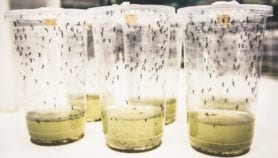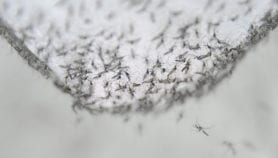By: Ochieng’ Ogodo
Send to a friend
The details you provide on this page will not be used to send unsolicited email, and will not be sold to a 3rd party. See privacy policy.
[KIGALI] Climbing beans suited to rainy high-altitude areas are being distributed in Rwanda after a decade of research.
The fifteen varieties, developed by the Rwandan Agricultural Research Institute (ISAR) in collaboration with the International Center for Tropical Agriculture (CIAT), could benefit smallholder farmers in similar areas across Central and East Africa.
Unlike the more commonly-planted ‘bush beans’, the beans are resistant to legume diseases such as anthracnose, root rot and ascochyta, which are found in damp, higher altitude areas.
The new climbing beans are also higher yielding, producing triple and even quadruple the yields of bush beans. The beans can be cultivated up two metres-high stakes — ideal for countries such as Rwanda where space is scarce — and reduce soil erosion in sloping areas that experience heavy rain, Augustine Musoni, bean breeder and coordinator of bean research at ISAR, told SciDev.Net.
And they can be grown year-round. "The climbing bean varieties do well in nutrient-poor soils and take about four months to mature, thus offering farmers the possibility for four planting seasons annually with a hectare yielding 3–4 tonnes each harvesting season," said Robin Buruchara, regional coordinator for CIAT in Africa.
Climbing beans are more often grown in Central American countries but are becoming more popular in Africa, said Musoni.
He added the new varieties, which ISAR began formally distributing to farmers last month (15 January), are good at nitrogen fixing, a process in which soil bacteria in the bean plant’s roots absorb nitrogen, which is then released into the soil and acts as a fertiliser.
The varieties are already proving popular. Rwandan farmer Alphonsin Nyirambranjinka said the new variety gives her yields almost three times that of the bush beans she used to grow. "The new variety gives good yields for us to eat at home and I sell the rest the local market. The beans also taste sweet."
Paul Kimani, a bean breeder and professor of plant breeding and genetics at the University of Nairobi, Kenya — where the new varieties have tripled yields — said the new varieties "fix between 5-40 kilograms of nitrogen per year per hectare, compared with maize, which fixes no nitrogen".
He added that the need to grow the beans up stakes could add to costs but higher yields would cover the extra expenditure. Kimani said the biggest barrier was getting the seeds to farmers.













